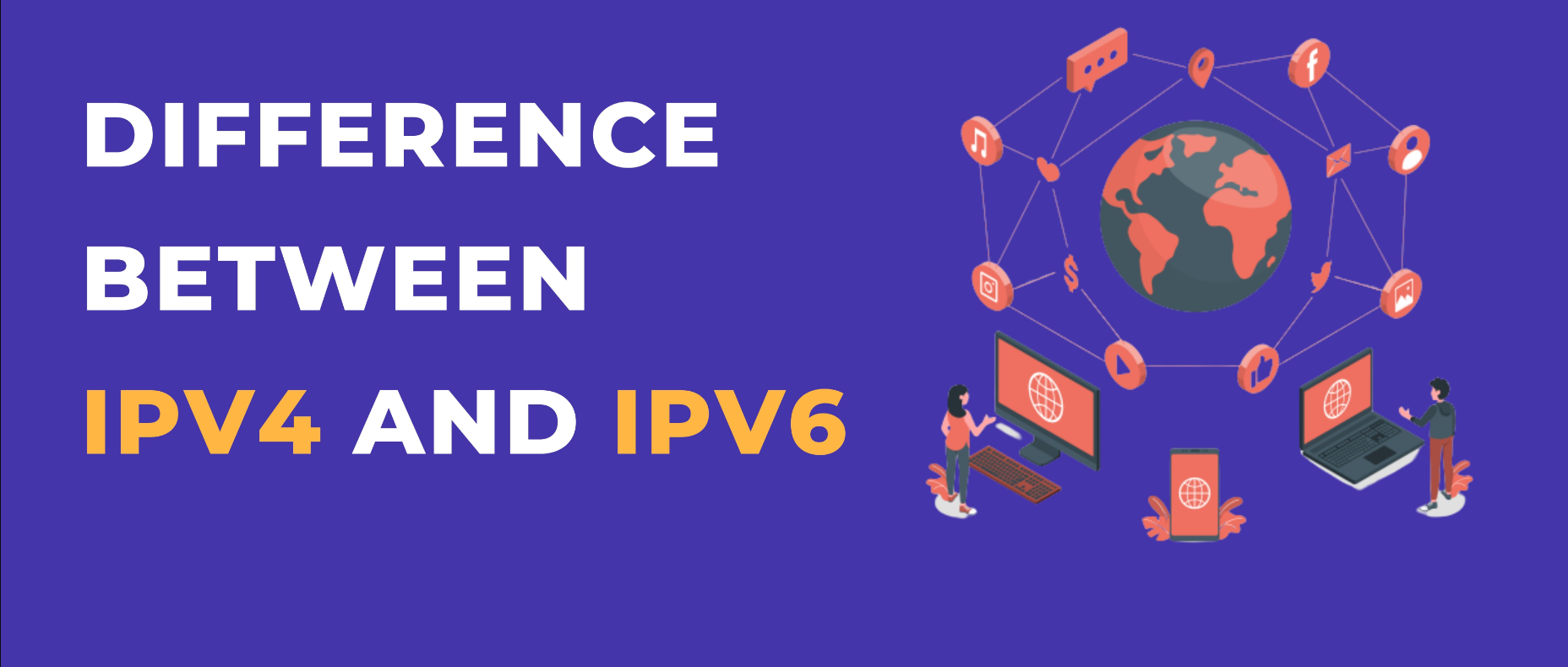In the vast world of the internet, IP addresses are the backbone of all communications. They ensure that data packets find their way from one device to another. There are two primary versions of IP addresses in use today: IPv4(Internet Protocol version 4) and IPv6(Internet Protocol version 6). Understanding the differences between these two protocols is crucial for anyone involved in networking, whether you’re a student, IT professional, or tech enthusiast. This blog post aims to demystify the key distinctions between IPv4 and IPv6 in a simple and comprehensive manner.
Table of Contents
What are IPv4 and IPv6?
IPv4

IPv4 stands for Internet Protocol version 4. It was the first version of the Internet Protocol to be widely used, and it still carries most of the world’s internet traffic. An IPv4 address is a 32-bit number, usually expressed in decimal format as four numbers separated by periods (e.g., 192.168.1.1). Each number can range from 0 to 255.
IPv6
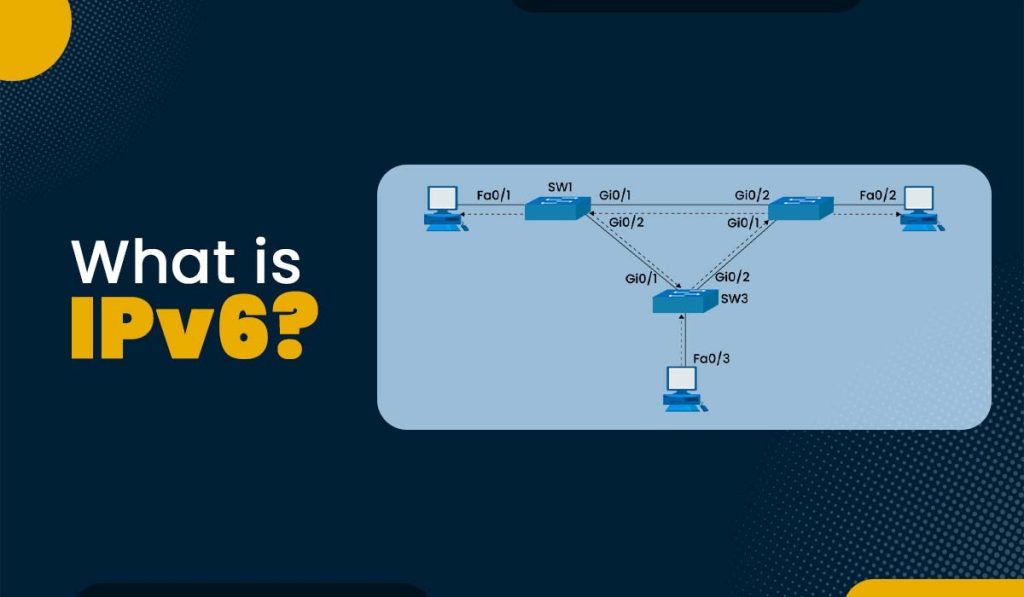
IPv6 stands for Internet Protocol version 6. It was developed to address the limitations and address exhaustion issues inherent in IPv4. An IPv6 address is a 128-bit number, typically written in hexadecimal and separated by colons (e.g., 2001:0db8:85a3:0000:0000:8a2e:0370:7334). This expansion allows for a vastly larger number of unique IP addresses.
Key Features of IPv4
IPv4 (Internet Protocol version 4) has been the foundational protocol for internet communication for many years. Here are the key features of IPv4 that have contributed to its widespread adoption and continued use:
1. Address Format
- 32-bit Addresses: IPv4 addresses are 32-bit numerical values, represented in decimal format. They are typically written as four octets separated by periods (e.g., 192.168.1.1).
- Dot-decimal Notation: Each of the four octets in an IPv4 address can range from 0 to 255.
2. Address Space
- Limited Address Space: IPv4 provides approximately 4.3 billion unique addresses (2^32). While this seemed sufficient during its initial development, it has become insufficient due to the rapid growth of the internet.
3. Address Classes and Subnetting
- Address Classes: IPv4 addresses are divided into five classes (A, B, C, D, and E), with classes A, B, and C being used for unicast addressing. This classification helps in organizing IP address allocation.
- Subnetting: Subnetting allows larger networks to be divided into smaller, more manageable segments. This helps optimize the use of IP addresses and improves network management.
4. Broadcast Communication
- Broadcast Support: IPv4 supports broadcast addressing, which allows data to be sent to all devices within a network segment. The broadcast address is typically the highest address in the network range (e.g., 192.168.1.255 for the network 192.168.1.0/24).
5. Address Resolution Protocol (ARP)
- ARP: IPv4 uses the Address Resolution Protocol to map IP addresses to MAC (Media Access Control) addresses within a local network. This is essential for enabling communication between devices on the same local network.
6. Network Address Translation (NAT)
- NAT: Due to the limited number of available IPv4 addresses, Network Address Translation is widely used. NAT allows multiple devices on a private network to share a single public IP address, conserving the global address space.
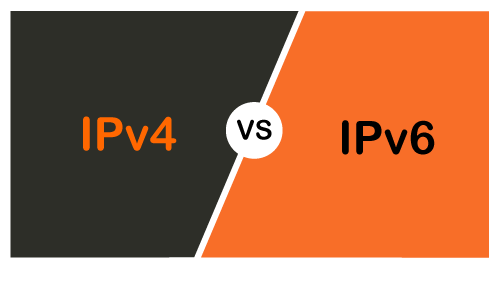
Key Features of IPv6(Internet Protocol version 6)
IPv6 (Internet Protocol version 6) is designed to address the limitations of IPv4 and provide a robust framework for the future growth of the internet. Here are the key features of IPv6 that set it apart from its predecessor:
1. Expanded Address Space
- 128-bit Addresses: IPv6(Internet Protocol version 6) addresses are 128 bits long, allowing for a vast number of unique IP addresses (approximately 3.4 x 10^38 addresses). This expansion ensures that the growing number of internet-connected devices can be accommodated without the risk of address exhaustion.
2. Address Notation
- Hexadecimal Format: IPv6 addresses are written in hexadecimal format and separated by colons (e.g., 2001:0db8:85a3:0000:0000:8a2e:0370:7334).
- Shorthand Notation: IPv6(Internet Protocol version 6) allows for shorthand notation by omitting leading zeros and using double colons (::) to replace consecutive sections of zeros, but only once per address (e.g., 2001:db8::8a2e:370:7334).
3. Hierarchical Addressing and Aggregation
- Hierarchical Structure: IPv6(Internet Protocol version 6) supports hierarchical addressing, which simplifies routing and address allocation. It allows for efficient aggregation of prefixes, reducing the size of routing tables and improving the scalability of the internet.
4. Stateless Address Autoconfiguration (SLAAC)
- Automatic Configuration: IPv6(Internet Protocol version 6) enables devices to automatically configure their own IP addresses without the need for a DHCP server. This process, known as SLAAC, simplifies network setup and management.
5. No Broadcast
- Elimination of Broadcast: IPv6(Internet Protocol version 6) does not use broadcast addressing, which reduces network congestion and improves security. Instead, IPv6 uses multicast and anycast addressing.
6. Improved Multicast and Anycast
- Multicast: IPv6(Internet Protocol version 6) enhances support for multicast addressing, allowing data to be sent to multiple destinations simultaneously. This is useful for applications such as video conferencing and streaming.
- Anycast: IPv6(Internet Protocol version 6) introduces anycast addressing, where packets are delivered to the nearest device in a group of potential receivers. This improves load balancing and redundancy.
Key Differences Between IPv4 and IPv6
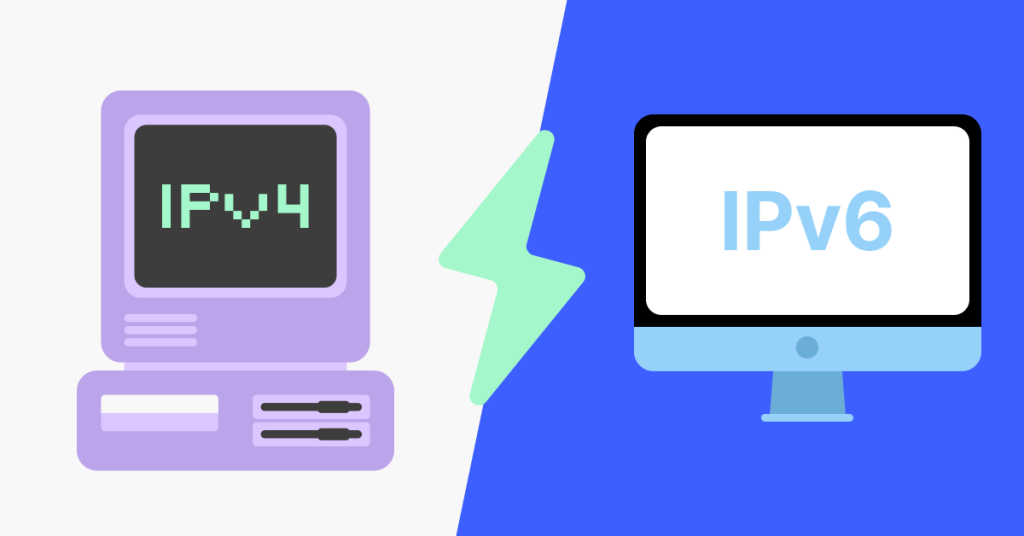
Address Space
The most significant difference between IPv4 and IPv6 is the size of their address spaces.
- IPv4: With 32 bits, IPv4 can support approximately 4.3 billion unique addresses. This seemed sufficient during its development, but with the explosive growth of the internet, the number of available IPv4 addresses has been exhausted.
- IPv6: IPv6(Internet Protocol version 6) uses 128-bit addresses, allowing for an astronomical number of unique addresses (approximately 3.4 x 10^38). This abundance ensures that we will not run out of IP addresses anytime soon.
Address Notation
How addresses are written and presented differs significantly between the two protocols.
- IPv4: As mentioned, IPv4 addresses are written in decimal format, such as 192.168.1.1.
- IPv6: IPv6(Internet Protocol version 6) addresses are written in hexadecimal format and are divided by colons, like 2001:0db8:85a3:0000:0000:8a2e:0370:7334. IPv6 also allows for shorthand notation by omitting leading zeros and replacing consecutive sections of zeros with double colons (::), but this can only be done once in an address.
Header Complexity
The header of an IP packet contains metadata about the packet itself, such as the source and destination addresses, and other relevant information.
- IPv4: The IPv4 header is 20-60 bytes long, depending on the presence of optional fields. It contains 12 mandatory fields and up to 40 bytes of optional fields.
- IPv6: The IPv6(Internet Protocol version 6) header is fixed at 40 bytes and is designed to be simpler and more efficient than the IPv4 header. It has 8 mandatory fields and uses extension headers for optional information, making the processing of packets faster and more efficient.
Configuration and Mobility
The way devices obtain IP addresses and handle mobility varies between IPv4 and IPv6.
- IPv4: IPv4 addresses can be assigned manually (static addressing) or automatically using the Dynamic Host Configuration Protocol (DHCP). Mobile IPv4 (MIPv4) allows for limited mobility, enabling devices to maintain connections while moving between networks, but it is relatively complex.
- IPv6: IPv6(Internet Protocol version 6) supports stateless address autoconfiguration (SLAAC), allowing devices to automatically configure their own IP addresses without the need for a DHCP server. IPv6 also has better support for mobile devices (Mobile IPv6 or MIPv6), making it easier for devices to maintain connections while moving between different networks.
Security
Security features in IP protocols help protect data integrity, confidentiality, and authenticity.
- IPv4: Security in IPv4 relies on external protocols such as IPsec, which can be optionally implemented to provide end-to-end encryption and authentication.
- IPv6: IPv6 was designed with security in mind from the start. IPsec support is mandatory in IPv6, providing built-in encryption and authentication, which enhances security across the board.
Fragmentation
Fragmentation is the process of breaking down large data packets into smaller fragments for transmission and reassembling them at the destination.
- IPv4: In IPv4, routers along the packet’s path can fragment packets if they are too large to pass through a network segment.
- IPv6: In IPv6(Internet Protocol version 6), fragmentation is handled by the sending device, not by routers. This reduces the processing load on routers and increases the overall efficiency of data transmission.
Address Types
Both IPv4 and IPv6 support multiple address types, but there are differences in their implementations.
- IPv4: IPv4 addresses include unicast (one-to-one), multicast (one-to-many), and broadcast (one-to-all).
- IPv6: IPv6(Internet Protocol version 6) also supports unicast and multicast, but replaces broadcast with anycast (one-to-nearest, many-to-one). Anycast allows a packet to be delivered to the nearest device in a group of potential receivers, improving load balancing and redundancy.
Network Address Translation (NAT)
NAT is a method used to extend the limited number of available IP addresses in IPv4.
- IPv4: Due to the scarcity of IPv4 addresses, NAT is widely used to allow multiple devices on a local network to share a single public IP address.
- IPv6: With its vast address space, IPv6 eliminates the need for NAT. Every device can have its own unique public IP address, simplifying network design and improving end-to-end connectivity.
Transition from IPv4 to IPv6
The transition from IPv4 to IPv6 is an ongoing process that involves various techniques to ensure compatibility and interoperability.
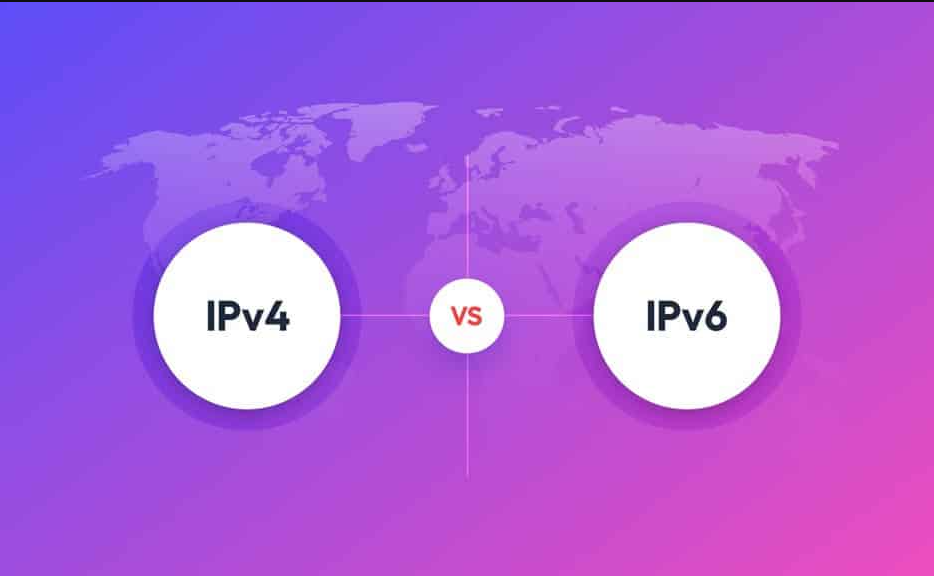
- Dual Stack: This approach allows devices to run both IPv4 and IPv6 simultaneously. It ensures compatibility with IPv4-only devices while gradually introducing IPv6.
- Tunneling: Tunneling involves encapsulating IPv6 packets within IPv4 packets to travel across IPv4 networks. Examples include 6to4 and Teredo.
- Translation: Network address translation techniques like NAT64 and DNS64 enable IPv6-only devices to communicate with IPv4-only devices by translating addresses and protocols.
Performance
IPv6(Internet Protocol version 6) offers several performance advantages over IPv4 due to its streamlined header structure, elimination of NAT, and enhanced support for modern network requirements.
- Simplified Header Processing: The fixed-length and simplified IPv6 header make packet processing more efficient, reducing the load on network devices and improving overall performance.
- Elimination of NAT: Removing NAT from the equation simplifies communication paths, reduces latency, and improves the reliability of end-to-end connectivity.
- Better Multicast and Anycast: Improved support for multicast and anycast in IPv6 enhances the efficiency of data distribution, particularly in applications like streaming and content delivery networks.
Adoption Challenges
Despite the clear advantages of IPv6(Internet Protocol version 6), its adoption has faced several challenges.
- Compatibility: Many existing systems, applications, and devices are designed to work with IPv4, requiring significant updates or replacements to support IPv6.
- Cost: Upgrading infrastructure, training personnel, and ensuring compatibility with IPv6 can be costly and time-consuming for organizations.
- Awareness: A lack of awareness and understanding of IPv6 benefits and implementation has slowed its adoption in some sectors.
Conclusion
IPv4 and IPv6 represent two generations of internet protocols, each with its own strengths and weaknesses. IPv4 has served us well for decades, but its limitations have become increasingly apparent as the internet continues to grow. IPv6 addresses these limitations with a vastly larger address space, improved efficiency, and enhanced security features.
The transition to IPv6(Internet Protocol version 6) is essential for the continued expansion and evolution of the internet. While the process presents challenges, the long-term benefits of adopting IPv6 far outweigh the temporary difficulties. As more devices and networks embrace IPv6, we move closer to a more robust, secure, and scalable internet that can support the demands of the future.

